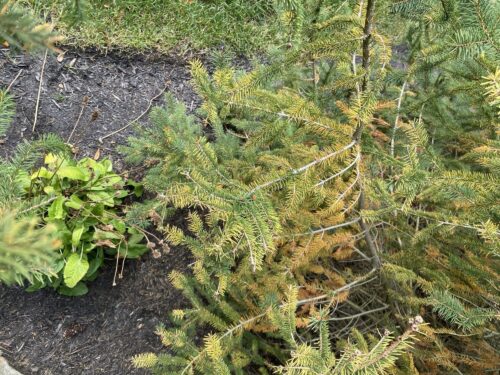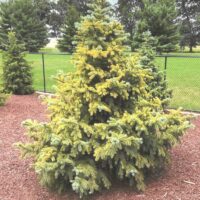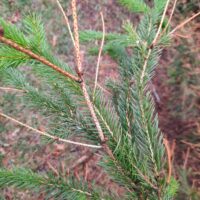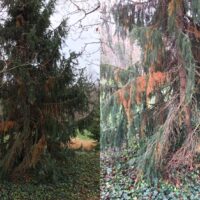 Purdue University - Extension - Forestry and Natural Resources
Purdue University - Extension - Forestry and Natural Resources
Got Nature? Blog
Posted on April 5th, 2021 in Disease, Forestry, Forests and Street Trees, How To, Plants | No Comments »
Purdue Landscape Report: We receive a large number of spruce samples each year at the Purdue Plant and Pest Diagnostic Laboratory (PPDL), with the vast majority being from Colorado blue spruce with needlecast. Many others show lower needle yellowing, which could be associated with nutrient deficiency or root stress.
However we are receiving an increasing number of Norway spruce samples with small branch dieback from the tips. This tip dieback symptom can have many causes: cold injury, root damage manifesting in branch dieback, Diplodia tip blight (caused by Diplodia sapinea, the same pathogen that causes tip blight in pine), and Cytospora canker. Phomopsis, another fungal pathogen which causes tip blight on spruce in nursery situations has been observed in greater frequency since 2012 by plant diagnostic labs in the North Central region causing cankers and tip dieback in more mature spruce trees in the landscape.
The disease begins in the lower canopy and moves upward, but in some cases it progresses quickly, causing dieback through a large portion of the tree. Besides needle death and drop, there are virtually no other external symptoms to indicate where the original infection took place. Occasionally you may find resin building on the outside of a canker. Cutting into the thin bark will show the brown discolored tissue where the canker is developing. Cankers are often located in between two areas of healthy tissue. This can lead to older needle loss similar to needlecast diseases, but leaving terminal buds alive. However, once the pathogen spreads and girdles the branch, the rest of the branch will begin to die out to the tip.
Resources
Borers of Pines and Other Needle Bearing Evergreens in Landscapes, The Education Store, Purdue Extension resource center
Ask an Expert Question: Blue Spruce dying, what can I do?, Got Nature? Blog, Purdue Extension – Forestry and Natural Resources
Why Spruce Trees Lose Their Needles, Purdue Extension
Diseases Common in Blue Spruce, Purdue Extension
John Bonkowski, Plant Disease Diagnostician
Purdue Department of Botany and Plant Pathology

Recent Posts
- HTIRC Continues to Protect Our Hardwood Forests
Posted: April 18, 2025 in Forestry, Timber Marketing, Woodlands - Tips to Manage Storm-Damaged Trees, Purdue Landscape Report
Posted: April 17, 2025 in Forests and Street Trees, How To, Urban Forestry - Liz Jackson Receives IHLA’s President’s Award, Featured in ANR Newsletter
Posted: in Forestry, Timber Marketing, Wildlife, Wood Products/Manufacturing, Woodlands - A Woodland Management Moment: Bottomland Forests
Posted: in Forests and Street Trees, Urban Forestry, Wildlife, Woodland Management Moment, Woodlands - When is the Peak Migration For Hummingbirds and How Can You Attract Them?
Posted: April 4, 2025 in How To, Wildlife - Smooth Patch of Oak – Purdue Landscape Report
Posted: March 27, 2025 in Forests and Street Trees, Urban Forestry, Wildlife, Woodlands - Prepared for Insects Waking Up? – PLR
Posted: March 26, 2025 in Forestry, Invasive Insects, Urban Forestry, Wildlife - ID That Tree: Invasive Autumn Olive
Posted: March 24, 2025 in Forestry, Invasive Plant Species, Urban Forestry, Wildlife, Woodlands - PPDL’s 2024 Annual Report – Enhancing Plant Health
Posted: March 21, 2025 in Forestry, Invasive Insects, Invasive Plant Species, Plants, Wildlife - Rays Sharing Their Award Winning Forest – Oak Management Forestry Field Day
Posted: March 20, 2025 in Forestry, How To, Invasive Plant Species, Wildlife, Woodlands
Archives
Categories
- Alert
- Aquaculture/Fish
- Aquatic/Aquaculture Resources
- Ask the Expert
- Christmas Trees
- Community Development
- Disease
- Drought
- Forestry
- Forests and Street Trees
- Gardening
- Got Nature for Kids
- Great Lakes
- How To
- Invasive Animal Species
- Invasive Insects
- Invasive Plant Species
- Land Use
- Natural Resource Planning
- Nature of Teaching
- Plants
- Podcasts
- Ponds
- Publication
- Safety
- Spiders
- Timber Marketing
- Uncategorized
- Urban Forestry
- Webinar
- Wildlife
- Wood Products/Manufacturing
- Woodland Management Moment
- Woodlands



